BULAW5915 Corporate Law Assignment: Insolvent Trading Analysis
VerifiedAdded on 2023/03/17
|12
|3379
|40
Homework Assignment
AI Summary
This assignment provides a detailed analysis of insolvent trading within the framework of Australian corporate law. It begins by defining insolvent trading and exploring whether it constitutes a fiduciary duty, referencing the Corporations Act 2001 and relevant case law. The assignment then examines the safe harbour defense, outlining its operation, limitations, and the factors considered in determining a 'better outcome' for the company and its creditors. A comparison between the safe harbour defence and the business judgment rule is also provided. The assignment further illustrates the limitations of the safe harbour defense through examples, addressing scenarios where the defense cannot be applied. Finally, the assignment concludes with a discussion on the impact of the legislation on voluntary insolvencies, and a case study evaluating the breach of directors' duties, including the duty to act in good faith, prevent insolvent trading, and not to use their position for personal advantage.
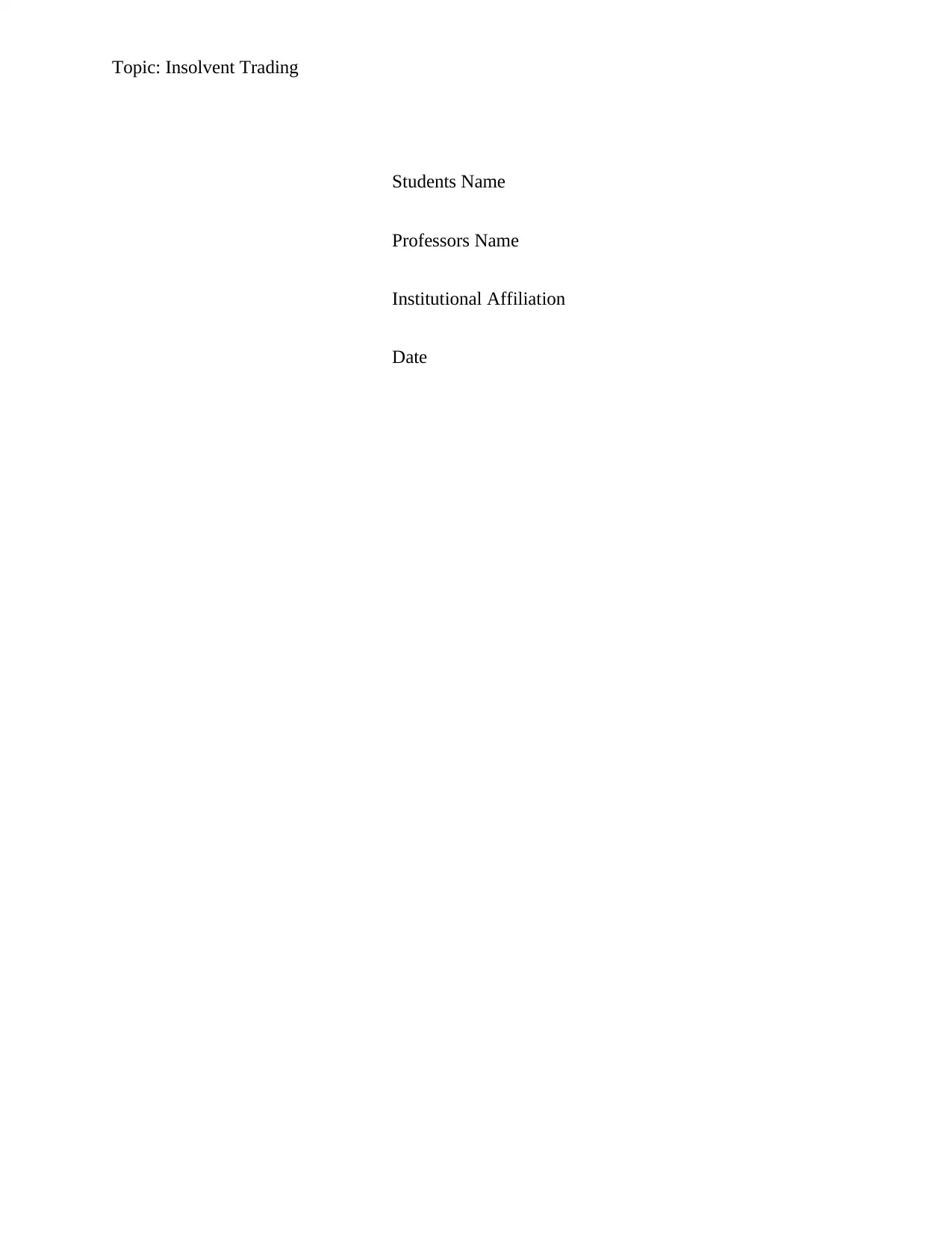
Topic: Insolvent Trading
Students Name
Professors Name
Institutional Affiliation
Date
Students Name
Professors Name
Institutional Affiliation
Date
Paraphrase This Document
Need a fresh take? Get an instant paraphrase of this document with our AI Paraphraser
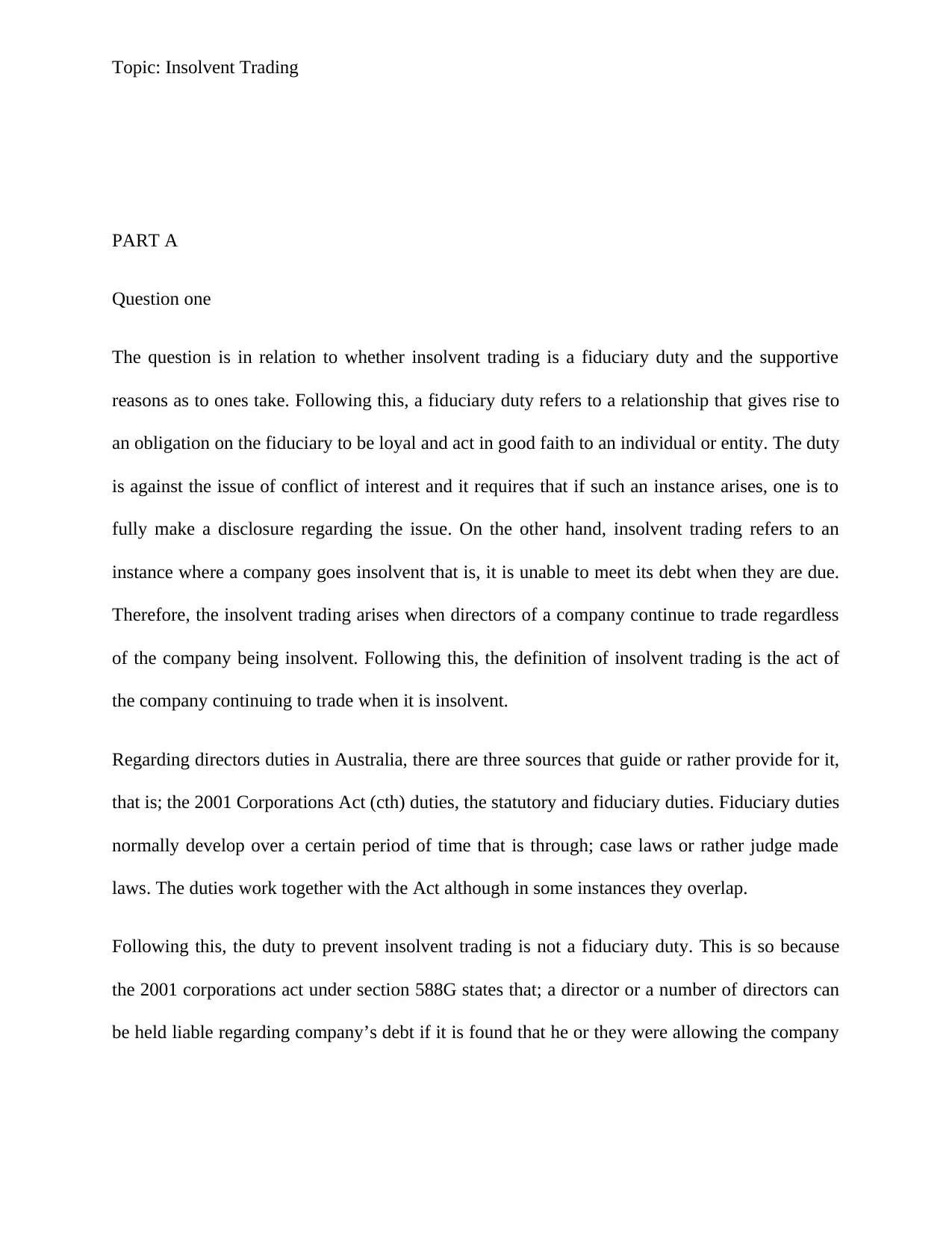
Topic: Insolvent Trading
PART A
Question one
The question is in relation to whether insolvent trading is a fiduciary duty and the supportive
reasons as to ones take. Following this, a fiduciary duty refers to a relationship that gives rise to
an obligation on the fiduciary to be loyal and act in good faith to an individual or entity. The duty
is against the issue of conflict of interest and it requires that if such an instance arises, one is to
fully make a disclosure regarding the issue. On the other hand, insolvent trading refers to an
instance where a company goes insolvent that is, it is unable to meet its debt when they are due.
Therefore, the insolvent trading arises when directors of a company continue to trade regardless
of the company being insolvent. Following this, the definition of insolvent trading is the act of
the company continuing to trade when it is insolvent.
Regarding directors duties in Australia, there are three sources that guide or rather provide for it,
that is; the 2001 Corporations Act (cth) duties, the statutory and fiduciary duties. Fiduciary duties
normally develop over a certain period of time that is through; case laws or rather judge made
laws. The duties work together with the Act although in some instances they overlap.
Following this, the duty to prevent insolvent trading is not a fiduciary duty. This is so because
the 2001 corporations act under section 588G states that; a director or a number of directors can
be held liable regarding company’s debt if it is found that he or they were allowing the company
PART A
Question one
The question is in relation to whether insolvent trading is a fiduciary duty and the supportive
reasons as to ones take. Following this, a fiduciary duty refers to a relationship that gives rise to
an obligation on the fiduciary to be loyal and act in good faith to an individual or entity. The duty
is against the issue of conflict of interest and it requires that if such an instance arises, one is to
fully make a disclosure regarding the issue. On the other hand, insolvent trading refers to an
instance where a company goes insolvent that is, it is unable to meet its debt when they are due.
Therefore, the insolvent trading arises when directors of a company continue to trade regardless
of the company being insolvent. Following this, the definition of insolvent trading is the act of
the company continuing to trade when it is insolvent.
Regarding directors duties in Australia, there are three sources that guide or rather provide for it,
that is; the 2001 Corporations Act (cth) duties, the statutory and fiduciary duties. Fiduciary duties
normally develop over a certain period of time that is through; case laws or rather judge made
laws. The duties work together with the Act although in some instances they overlap.
Following this, the duty to prevent insolvent trading is not a fiduciary duty. This is so because
the 2001 corporations act under section 588G states that; a director or a number of directors can
be held liable regarding company’s debt if it is found that he or they were allowing the company
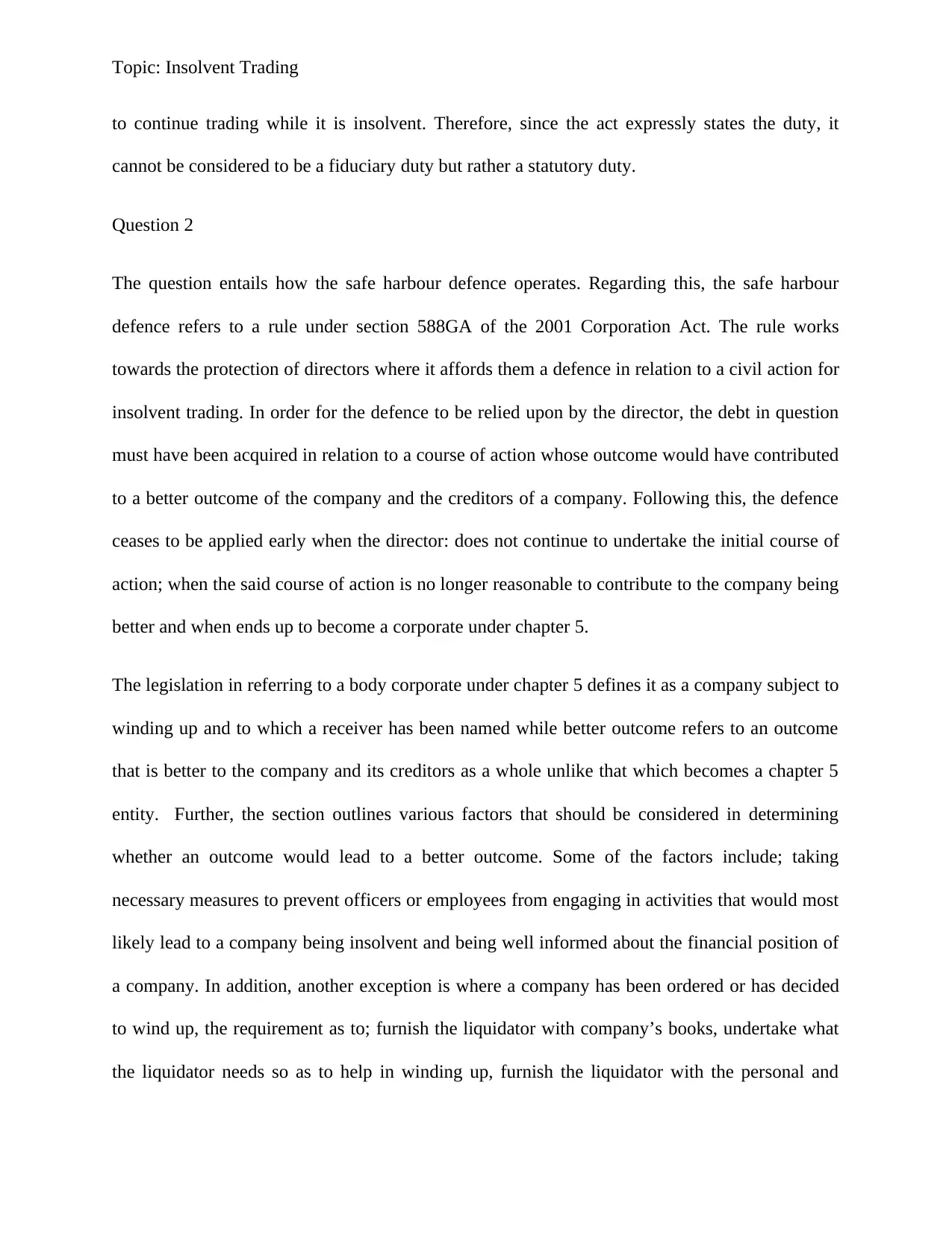
Topic: Insolvent Trading
to continue trading while it is insolvent. Therefore, since the act expressly states the duty, it
cannot be considered to be a fiduciary duty but rather a statutory duty.
Question 2
The question entails how the safe harbour defence operates. Regarding this, the safe harbour
defence refers to a rule under section 588GA of the 2001 Corporation Act. The rule works
towards the protection of directors where it affords them a defence in relation to a civil action for
insolvent trading. In order for the defence to be relied upon by the director, the debt in question
must have been acquired in relation to a course of action whose outcome would have contributed
to a better outcome of the company and the creditors of a company. Following this, the defence
ceases to be applied early when the director: does not continue to undertake the initial course of
action; when the said course of action is no longer reasonable to contribute to the company being
better and when ends up to become a corporate under chapter 5.
The legislation in referring to a body corporate under chapter 5 defines it as a company subject to
winding up and to which a receiver has been named while better outcome refers to an outcome
that is better to the company and its creditors as a whole unlike that which becomes a chapter 5
entity. Further, the section outlines various factors that should be considered in determining
whether an outcome would lead to a better outcome. Some of the factors include; taking
necessary measures to prevent officers or employees from engaging in activities that would most
likely lead to a company being insolvent and being well informed about the financial position of
a company. In addition, another exception is where a company has been ordered or has decided
to wind up, the requirement as to; furnish the liquidator with company’s books, undertake what
the liquidator needs so as to help in winding up, furnish the liquidator with the personal and
to continue trading while it is insolvent. Therefore, since the act expressly states the duty, it
cannot be considered to be a fiduciary duty but rather a statutory duty.
Question 2
The question entails how the safe harbour defence operates. Regarding this, the safe harbour
defence refers to a rule under section 588GA of the 2001 Corporation Act. The rule works
towards the protection of directors where it affords them a defence in relation to a civil action for
insolvent trading. In order for the defence to be relied upon by the director, the debt in question
must have been acquired in relation to a course of action whose outcome would have contributed
to a better outcome of the company and the creditors of a company. Following this, the defence
ceases to be applied early when the director: does not continue to undertake the initial course of
action; when the said course of action is no longer reasonable to contribute to the company being
better and when ends up to become a corporate under chapter 5.
The legislation in referring to a body corporate under chapter 5 defines it as a company subject to
winding up and to which a receiver has been named while better outcome refers to an outcome
that is better to the company and its creditors as a whole unlike that which becomes a chapter 5
entity. Further, the section outlines various factors that should be considered in determining
whether an outcome would lead to a better outcome. Some of the factors include; taking
necessary measures to prevent officers or employees from engaging in activities that would most
likely lead to a company being insolvent and being well informed about the financial position of
a company. In addition, another exception is where a company has been ordered or has decided
to wind up, the requirement as to; furnish the liquidator with company’s books, undertake what
the liquidator needs so as to help in winding up, furnish the liquidator with the personal and
⊘ This is a preview!⊘
Do you want full access?
Subscribe today to unlock all pages.

Trusted by 1+ million students worldwide
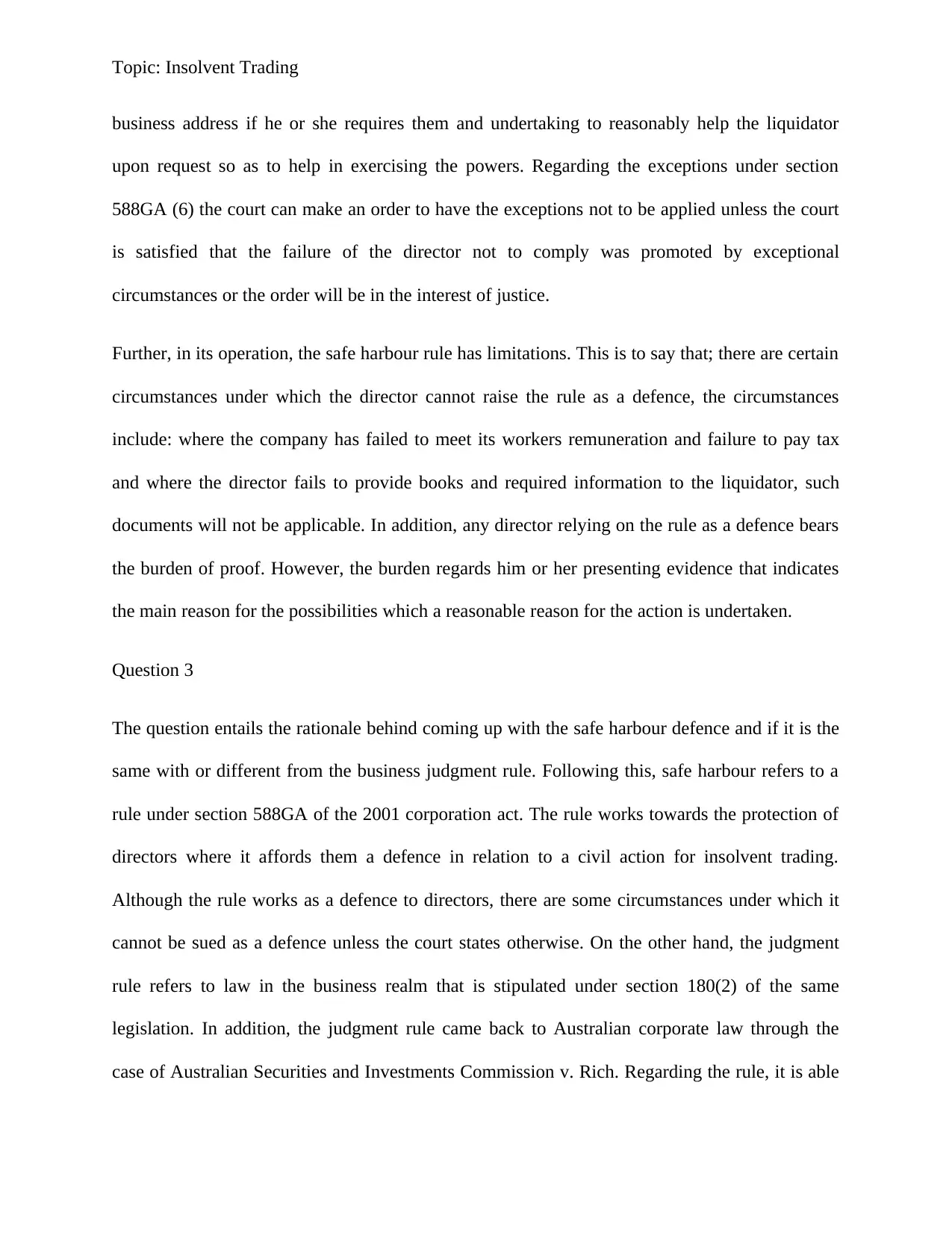
Topic: Insolvent Trading
business address if he or she requires them and undertaking to reasonably help the liquidator
upon request so as to help in exercising the powers. Regarding the exceptions under section
588GA (6) the court can make an order to have the exceptions not to be applied unless the court
is satisfied that the failure of the director not to comply was promoted by exceptional
circumstances or the order will be in the interest of justice.
Further, in its operation, the safe harbour rule has limitations. This is to say that; there are certain
circumstances under which the director cannot raise the rule as a defence, the circumstances
include: where the company has failed to meet its workers remuneration and failure to pay tax
and where the director fails to provide books and required information to the liquidator, such
documents will not be applicable. In addition, any director relying on the rule as a defence bears
the burden of proof. However, the burden regards him or her presenting evidence that indicates
the main reason for the possibilities which a reasonable reason for the action is undertaken.
Question 3
The question entails the rationale behind coming up with the safe harbour defence and if it is the
same with or different from the business judgment rule. Following this, safe harbour refers to a
rule under section 588GA of the 2001 corporation act. The rule works towards the protection of
directors where it affords them a defence in relation to a civil action for insolvent trading.
Although the rule works as a defence to directors, there are some circumstances under which it
cannot be sued as a defence unless the court states otherwise. On the other hand, the judgment
rule refers to law in the business realm that is stipulated under section 180(2) of the same
legislation. In addition, the judgment rule came back to Australian corporate law through the
case of Australian Securities and Investments Commission v. Rich. Regarding the rule, it is able
business address if he or she requires them and undertaking to reasonably help the liquidator
upon request so as to help in exercising the powers. Regarding the exceptions under section
588GA (6) the court can make an order to have the exceptions not to be applied unless the court
is satisfied that the failure of the director not to comply was promoted by exceptional
circumstances or the order will be in the interest of justice.
Further, in its operation, the safe harbour rule has limitations. This is to say that; there are certain
circumstances under which the director cannot raise the rule as a defence, the circumstances
include: where the company has failed to meet its workers remuneration and failure to pay tax
and where the director fails to provide books and required information to the liquidator, such
documents will not be applicable. In addition, any director relying on the rule as a defence bears
the burden of proof. However, the burden regards him or her presenting evidence that indicates
the main reason for the possibilities which a reasonable reason for the action is undertaken.
Question 3
The question entails the rationale behind coming up with the safe harbour defence and if it is the
same with or different from the business judgment rule. Following this, safe harbour refers to a
rule under section 588GA of the 2001 corporation act. The rule works towards the protection of
directors where it affords them a defence in relation to a civil action for insolvent trading.
Although the rule works as a defence to directors, there are some circumstances under which it
cannot be sued as a defence unless the court states otherwise. On the other hand, the judgment
rule refers to law in the business realm that is stipulated under section 180(2) of the same
legislation. In addition, the judgment rule came back to Australian corporate law through the
case of Australian Securities and Investments Commission v. Rich. Regarding the rule, it is able
Paraphrase This Document
Need a fresh take? Get an instant paraphrase of this document with our AI Paraphraser
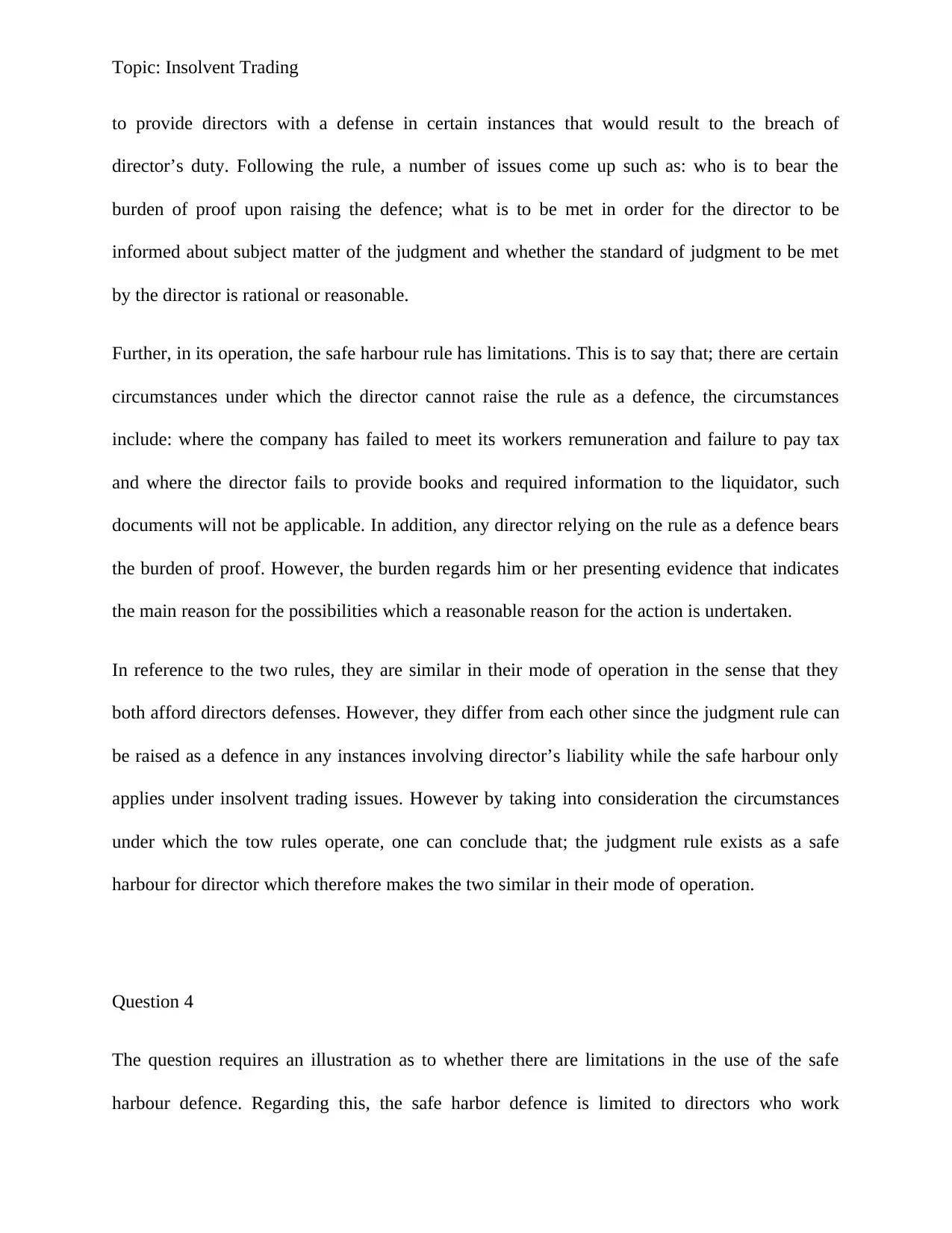
Topic: Insolvent Trading
to provide directors with a defense in certain instances that would result to the breach of
director’s duty. Following the rule, a number of issues come up such as: who is to bear the
burden of proof upon raising the defence; what is to be met in order for the director to be
informed about subject matter of the judgment and whether the standard of judgment to be met
by the director is rational or reasonable.
Further, in its operation, the safe harbour rule has limitations. This is to say that; there are certain
circumstances under which the director cannot raise the rule as a defence, the circumstances
include: where the company has failed to meet its workers remuneration and failure to pay tax
and where the director fails to provide books and required information to the liquidator, such
documents will not be applicable. In addition, any director relying on the rule as a defence bears
the burden of proof. However, the burden regards him or her presenting evidence that indicates
the main reason for the possibilities which a reasonable reason for the action is undertaken.
In reference to the two rules, they are similar in their mode of operation in the sense that they
both afford directors defenses. However, they differ from each other since the judgment rule can
be raised as a defence in any instances involving director’s liability while the safe harbour only
applies under insolvent trading issues. However by taking into consideration the circumstances
under which the tow rules operate, one can conclude that; the judgment rule exists as a safe
harbour for director which therefore makes the two similar in their mode of operation.
Question 4
The question requires an illustration as to whether there are limitations in the use of the safe
harbour defence. Regarding this, the safe harbor defence is limited to directors who work
to provide directors with a defense in certain instances that would result to the breach of
director’s duty. Following the rule, a number of issues come up such as: who is to bear the
burden of proof upon raising the defence; what is to be met in order for the director to be
informed about subject matter of the judgment and whether the standard of judgment to be met
by the director is rational or reasonable.
Further, in its operation, the safe harbour rule has limitations. This is to say that; there are certain
circumstances under which the director cannot raise the rule as a defence, the circumstances
include: where the company has failed to meet its workers remuneration and failure to pay tax
and where the director fails to provide books and required information to the liquidator, such
documents will not be applicable. In addition, any director relying on the rule as a defence bears
the burden of proof. However, the burden regards him or her presenting evidence that indicates
the main reason for the possibilities which a reasonable reason for the action is undertaken.
In reference to the two rules, they are similar in their mode of operation in the sense that they
both afford directors defenses. However, they differ from each other since the judgment rule can
be raised as a defence in any instances involving director’s liability while the safe harbour only
applies under insolvent trading issues. However by taking into consideration the circumstances
under which the tow rules operate, one can conclude that; the judgment rule exists as a safe
harbour for director which therefore makes the two similar in their mode of operation.
Question 4
The question requires an illustration as to whether there are limitations in the use of the safe
harbour defence. Regarding this, the safe harbor defence is limited to directors who work
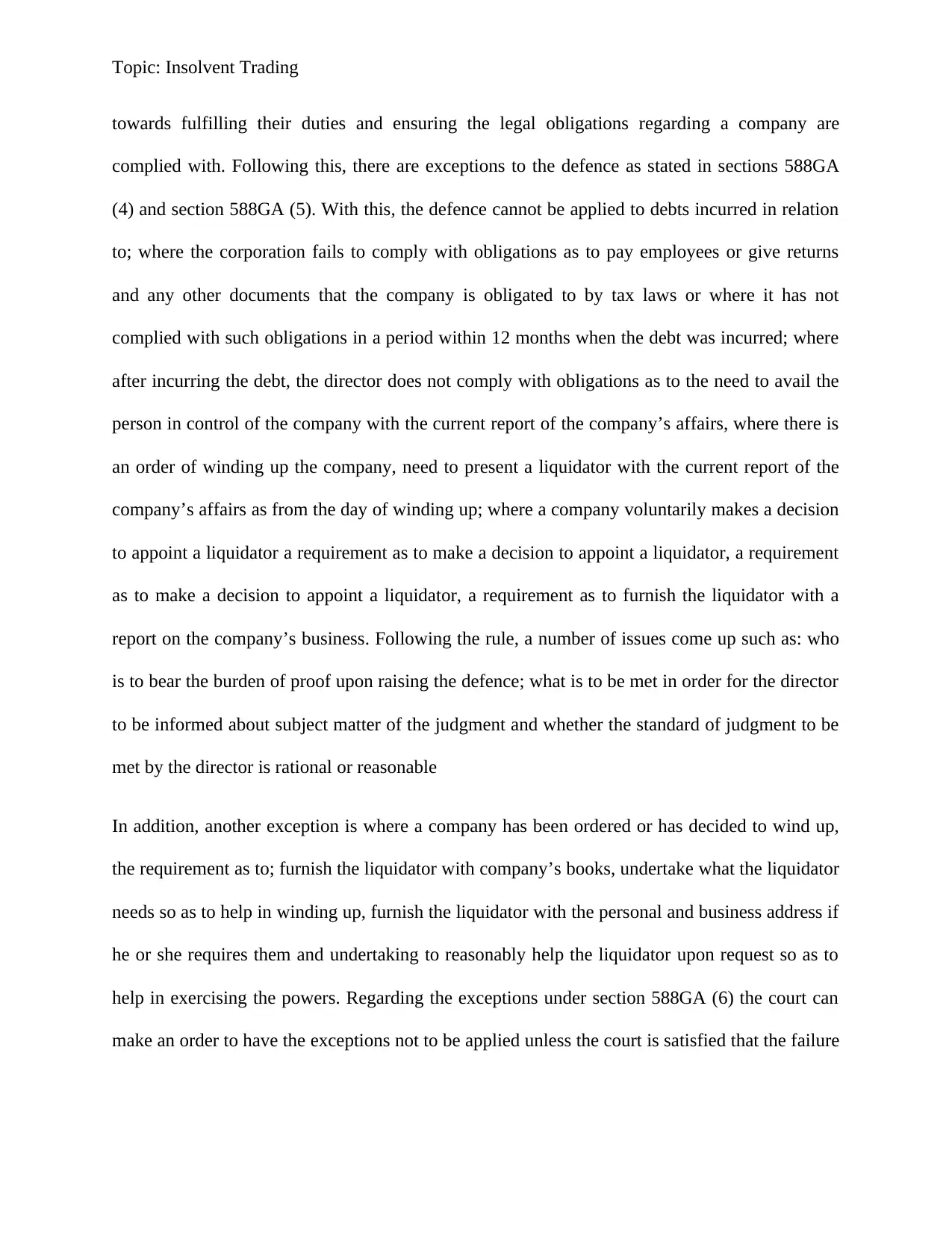
Topic: Insolvent Trading
towards fulfilling their duties and ensuring the legal obligations regarding a company are
complied with. Following this, there are exceptions to the defence as stated in sections 588GA
(4) and section 588GA (5). With this, the defence cannot be applied to debts incurred in relation
to; where the corporation fails to comply with obligations as to pay employees or give returns
and any other documents that the company is obligated to by tax laws or where it has not
complied with such obligations in a period within 12 months when the debt was incurred; where
after incurring the debt, the director does not comply with obligations as to the need to avail the
person in control of the company with the current report of the company’s affairs, where there is
an order of winding up the company, need to present a liquidator with the current report of the
company’s affairs as from the day of winding up; where a company voluntarily makes a decision
to appoint a liquidator a requirement as to make a decision to appoint a liquidator, a requirement
as to make a decision to appoint a liquidator, a requirement as to furnish the liquidator with a
report on the company’s business. Following the rule, a number of issues come up such as: who
is to bear the burden of proof upon raising the defence; what is to be met in order for the director
to be informed about subject matter of the judgment and whether the standard of judgment to be
met by the director is rational or reasonable
In addition, another exception is where a company has been ordered or has decided to wind up,
the requirement as to; furnish the liquidator with company’s books, undertake what the liquidator
needs so as to help in winding up, furnish the liquidator with the personal and business address if
he or she requires them and undertaking to reasonably help the liquidator upon request so as to
help in exercising the powers. Regarding the exceptions under section 588GA (6) the court can
make an order to have the exceptions not to be applied unless the court is satisfied that the failure
towards fulfilling their duties and ensuring the legal obligations regarding a company are
complied with. Following this, there are exceptions to the defence as stated in sections 588GA
(4) and section 588GA (5). With this, the defence cannot be applied to debts incurred in relation
to; where the corporation fails to comply with obligations as to pay employees or give returns
and any other documents that the company is obligated to by tax laws or where it has not
complied with such obligations in a period within 12 months when the debt was incurred; where
after incurring the debt, the director does not comply with obligations as to the need to avail the
person in control of the company with the current report of the company’s affairs, where there is
an order of winding up the company, need to present a liquidator with the current report of the
company’s affairs as from the day of winding up; where a company voluntarily makes a decision
to appoint a liquidator a requirement as to make a decision to appoint a liquidator, a requirement
as to make a decision to appoint a liquidator, a requirement as to furnish the liquidator with a
report on the company’s business. Following the rule, a number of issues come up such as: who
is to bear the burden of proof upon raising the defence; what is to be met in order for the director
to be informed about subject matter of the judgment and whether the standard of judgment to be
met by the director is rational or reasonable
In addition, another exception is where a company has been ordered or has decided to wind up,
the requirement as to; furnish the liquidator with company’s books, undertake what the liquidator
needs so as to help in winding up, furnish the liquidator with the personal and business address if
he or she requires them and undertaking to reasonably help the liquidator upon request so as to
help in exercising the powers. Regarding the exceptions under section 588GA (6) the court can
make an order to have the exceptions not to be applied unless the court is satisfied that the failure
⊘ This is a preview!⊘
Do you want full access?
Subscribe today to unlock all pages.

Trusted by 1+ million students worldwide
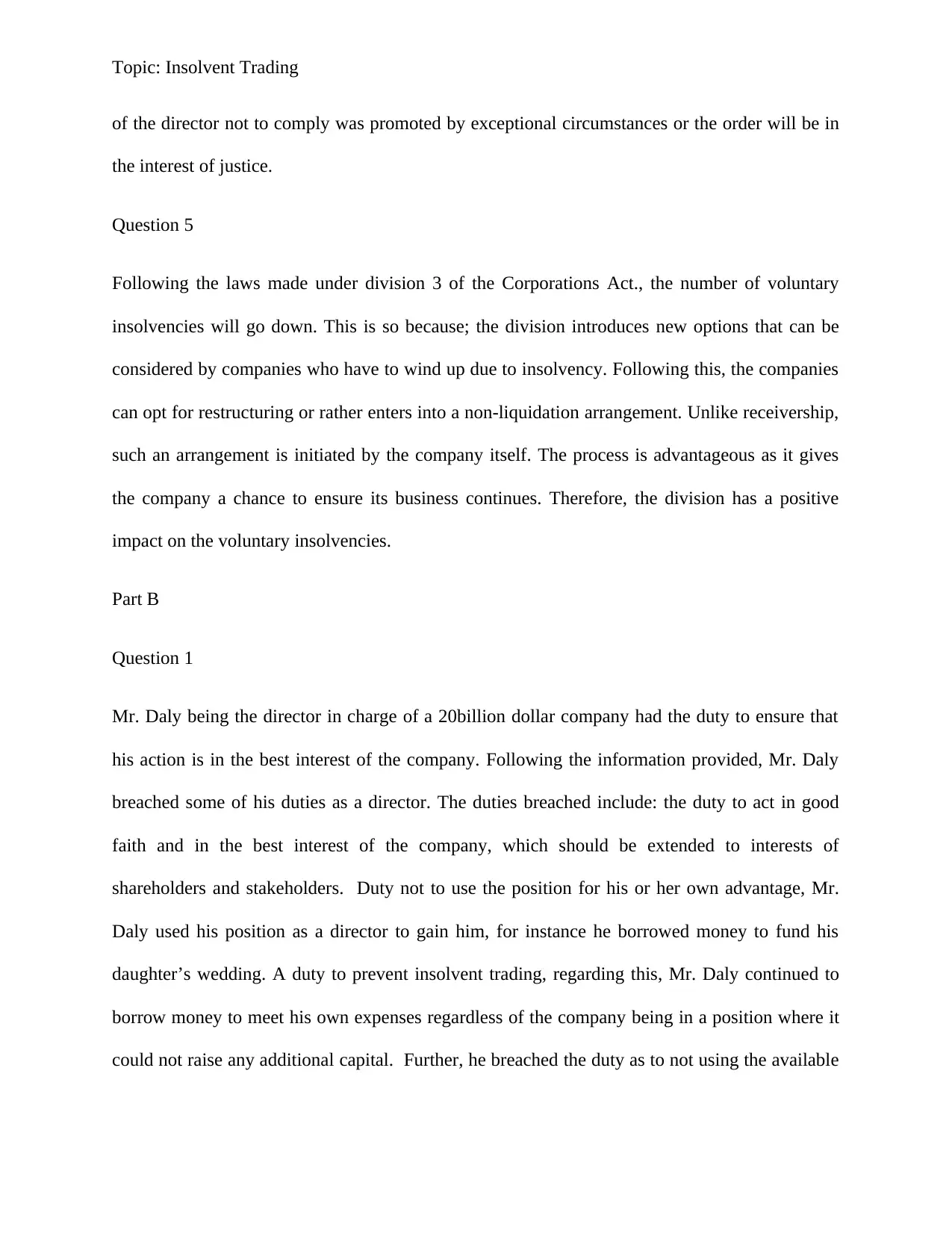
Topic: Insolvent Trading
of the director not to comply was promoted by exceptional circumstances or the order will be in
the interest of justice.
Question 5
Following the laws made under division 3 of the Corporations Act., the number of voluntary
insolvencies will go down. This is so because; the division introduces new options that can be
considered by companies who have to wind up due to insolvency. Following this, the companies
can opt for restructuring or rather enters into a non-liquidation arrangement. Unlike receivership,
such an arrangement is initiated by the company itself. The process is advantageous as it gives
the company a chance to ensure its business continues. Therefore, the division has a positive
impact on the voluntary insolvencies.
Part B
Question 1
Mr. Daly being the director in charge of a 20billion dollar company had the duty to ensure that
his action is in the best interest of the company. Following the information provided, Mr. Daly
breached some of his duties as a director. The duties breached include: the duty to act in good
faith and in the best interest of the company, which should be extended to interests of
shareholders and stakeholders. Duty not to use the position for his or her own advantage, Mr.
Daly used his position as a director to gain him, for instance he borrowed money to fund his
daughter’s wedding. A duty to prevent insolvent trading, regarding this, Mr. Daly continued to
borrow money to meet his own expenses regardless of the company being in a position where it
could not raise any additional capital. Further, he breached the duty as to not using the available
of the director not to comply was promoted by exceptional circumstances or the order will be in
the interest of justice.
Question 5
Following the laws made under division 3 of the Corporations Act., the number of voluntary
insolvencies will go down. This is so because; the division introduces new options that can be
considered by companies who have to wind up due to insolvency. Following this, the companies
can opt for restructuring or rather enters into a non-liquidation arrangement. Unlike receivership,
such an arrangement is initiated by the company itself. The process is advantageous as it gives
the company a chance to ensure its business continues. Therefore, the division has a positive
impact on the voluntary insolvencies.
Part B
Question 1
Mr. Daly being the director in charge of a 20billion dollar company had the duty to ensure that
his action is in the best interest of the company. Following the information provided, Mr. Daly
breached some of his duties as a director. The duties breached include: the duty to act in good
faith and in the best interest of the company, which should be extended to interests of
shareholders and stakeholders. Duty not to use the position for his or her own advantage, Mr.
Daly used his position as a director to gain him, for instance he borrowed money to fund his
daughter’s wedding. A duty to prevent insolvent trading, regarding this, Mr. Daly continued to
borrow money to meet his own expenses regardless of the company being in a position where it
could not raise any additional capital. Further, he breached the duty as to not using the available
Paraphrase This Document
Need a fresh take? Get an instant paraphrase of this document with our AI Paraphraser
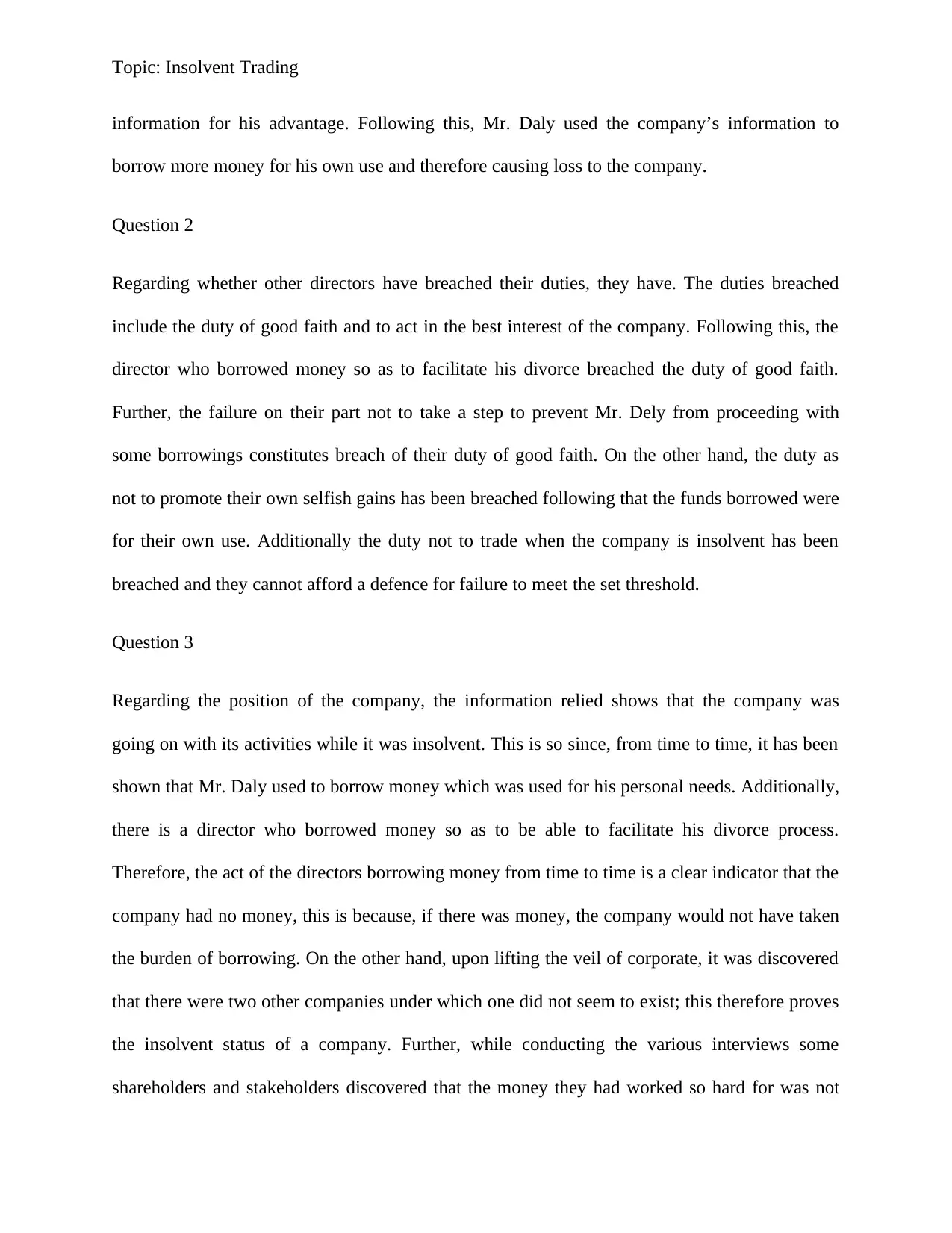
Topic: Insolvent Trading
information for his advantage. Following this, Mr. Daly used the company’s information to
borrow more money for his own use and therefore causing loss to the company.
Question 2
Regarding whether other directors have breached their duties, they have. The duties breached
include the duty of good faith and to act in the best interest of the company. Following this, the
director who borrowed money so as to facilitate his divorce breached the duty of good faith.
Further, the failure on their part not to take a step to prevent Mr. Dely from proceeding with
some borrowings constitutes breach of their duty of good faith. On the other hand, the duty as
not to promote their own selfish gains has been breached following that the funds borrowed were
for their own use. Additionally the duty not to trade when the company is insolvent has been
breached and they cannot afford a defence for failure to meet the set threshold.
Question 3
Regarding the position of the company, the information relied shows that the company was
going on with its activities while it was insolvent. This is so since, from time to time, it has been
shown that Mr. Daly used to borrow money which was used for his personal needs. Additionally,
there is a director who borrowed money so as to be able to facilitate his divorce process.
Therefore, the act of the directors borrowing money from time to time is a clear indicator that the
company had no money, this is because, if there was money, the company would not have taken
the burden of borrowing. On the other hand, upon lifting the veil of corporate, it was discovered
that there were two other companies under which one did not seem to exist; this therefore proves
the insolvent status of a company. Further, while conducting the various interviews some
shareholders and stakeholders discovered that the money they had worked so hard for was not
information for his advantage. Following this, Mr. Daly used the company’s information to
borrow more money for his own use and therefore causing loss to the company.
Question 2
Regarding whether other directors have breached their duties, they have. The duties breached
include the duty of good faith and to act in the best interest of the company. Following this, the
director who borrowed money so as to facilitate his divorce breached the duty of good faith.
Further, the failure on their part not to take a step to prevent Mr. Dely from proceeding with
some borrowings constitutes breach of their duty of good faith. On the other hand, the duty as
not to promote their own selfish gains has been breached following that the funds borrowed were
for their own use. Additionally the duty not to trade when the company is insolvent has been
breached and they cannot afford a defence for failure to meet the set threshold.
Question 3
Regarding the position of the company, the information relied shows that the company was
going on with its activities while it was insolvent. This is so since, from time to time, it has been
shown that Mr. Daly used to borrow money which was used for his personal needs. Additionally,
there is a director who borrowed money so as to be able to facilitate his divorce process.
Therefore, the act of the directors borrowing money from time to time is a clear indicator that the
company had no money, this is because, if there was money, the company would not have taken
the burden of borrowing. On the other hand, upon lifting the veil of corporate, it was discovered
that there were two other companies under which one did not seem to exist; this therefore proves
the insolvent status of a company. Further, while conducting the various interviews some
shareholders and stakeholders discovered that the money they had worked so hard for was not
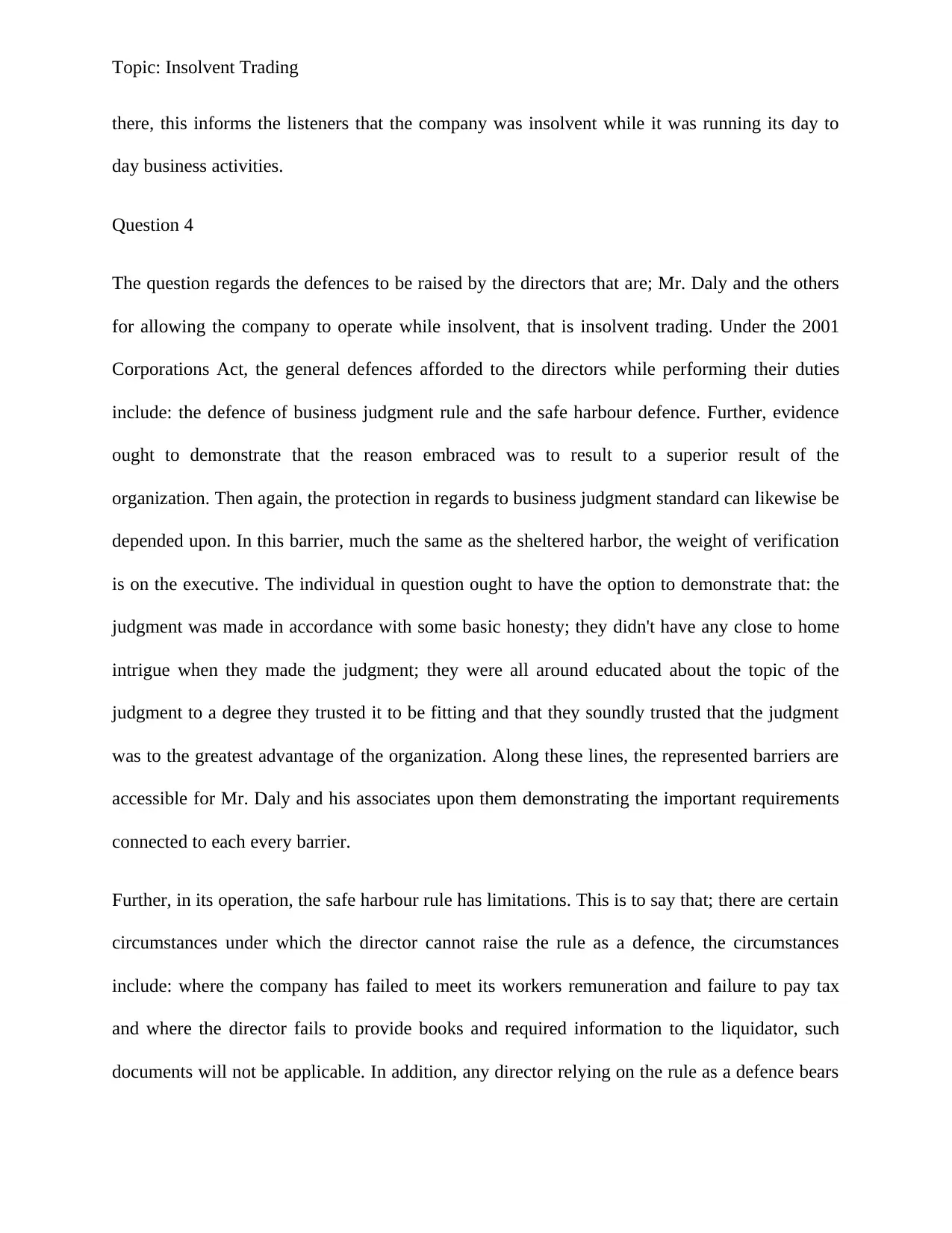
Topic: Insolvent Trading
there, this informs the listeners that the company was insolvent while it was running its day to
day business activities.
Question 4
The question regards the defences to be raised by the directors that are; Mr. Daly and the others
for allowing the company to operate while insolvent, that is insolvent trading. Under the 2001
Corporations Act, the general defences afforded to the directors while performing their duties
include: the defence of business judgment rule and the safe harbour defence. Further, evidence
ought to demonstrate that the reason embraced was to result to a superior result of the
organization. Then again, the protection in regards to business judgment standard can likewise be
depended upon. In this barrier, much the same as the sheltered harbor, the weight of verification
is on the executive. The individual in question ought to have the option to demonstrate that: the
judgment was made in accordance with some basic honesty; they didn't have any close to home
intrigue when they made the judgment; they were all around educated about the topic of the
judgment to a degree they trusted it to be fitting and that they soundly trusted that the judgment
was to the greatest advantage of the organization. Along these lines, the represented barriers are
accessible for Mr. Daly and his associates upon them demonstrating the important requirements
connected to each every barrier.
Further, in its operation, the safe harbour rule has limitations. This is to say that; there are certain
circumstances under which the director cannot raise the rule as a defence, the circumstances
include: where the company has failed to meet its workers remuneration and failure to pay tax
and where the director fails to provide books and required information to the liquidator, such
documents will not be applicable. In addition, any director relying on the rule as a defence bears
there, this informs the listeners that the company was insolvent while it was running its day to
day business activities.
Question 4
The question regards the defences to be raised by the directors that are; Mr. Daly and the others
for allowing the company to operate while insolvent, that is insolvent trading. Under the 2001
Corporations Act, the general defences afforded to the directors while performing their duties
include: the defence of business judgment rule and the safe harbour defence. Further, evidence
ought to demonstrate that the reason embraced was to result to a superior result of the
organization. Then again, the protection in regards to business judgment standard can likewise be
depended upon. In this barrier, much the same as the sheltered harbor, the weight of verification
is on the executive. The individual in question ought to have the option to demonstrate that: the
judgment was made in accordance with some basic honesty; they didn't have any close to home
intrigue when they made the judgment; they were all around educated about the topic of the
judgment to a degree they trusted it to be fitting and that they soundly trusted that the judgment
was to the greatest advantage of the organization. Along these lines, the represented barriers are
accessible for Mr. Daly and his associates upon them demonstrating the important requirements
connected to each every barrier.
Further, in its operation, the safe harbour rule has limitations. This is to say that; there are certain
circumstances under which the director cannot raise the rule as a defence, the circumstances
include: where the company has failed to meet its workers remuneration and failure to pay tax
and where the director fails to provide books and required information to the liquidator, such
documents will not be applicable. In addition, any director relying on the rule as a defence bears
⊘ This is a preview!⊘
Do you want full access?
Subscribe today to unlock all pages.

Trusted by 1+ million students worldwide
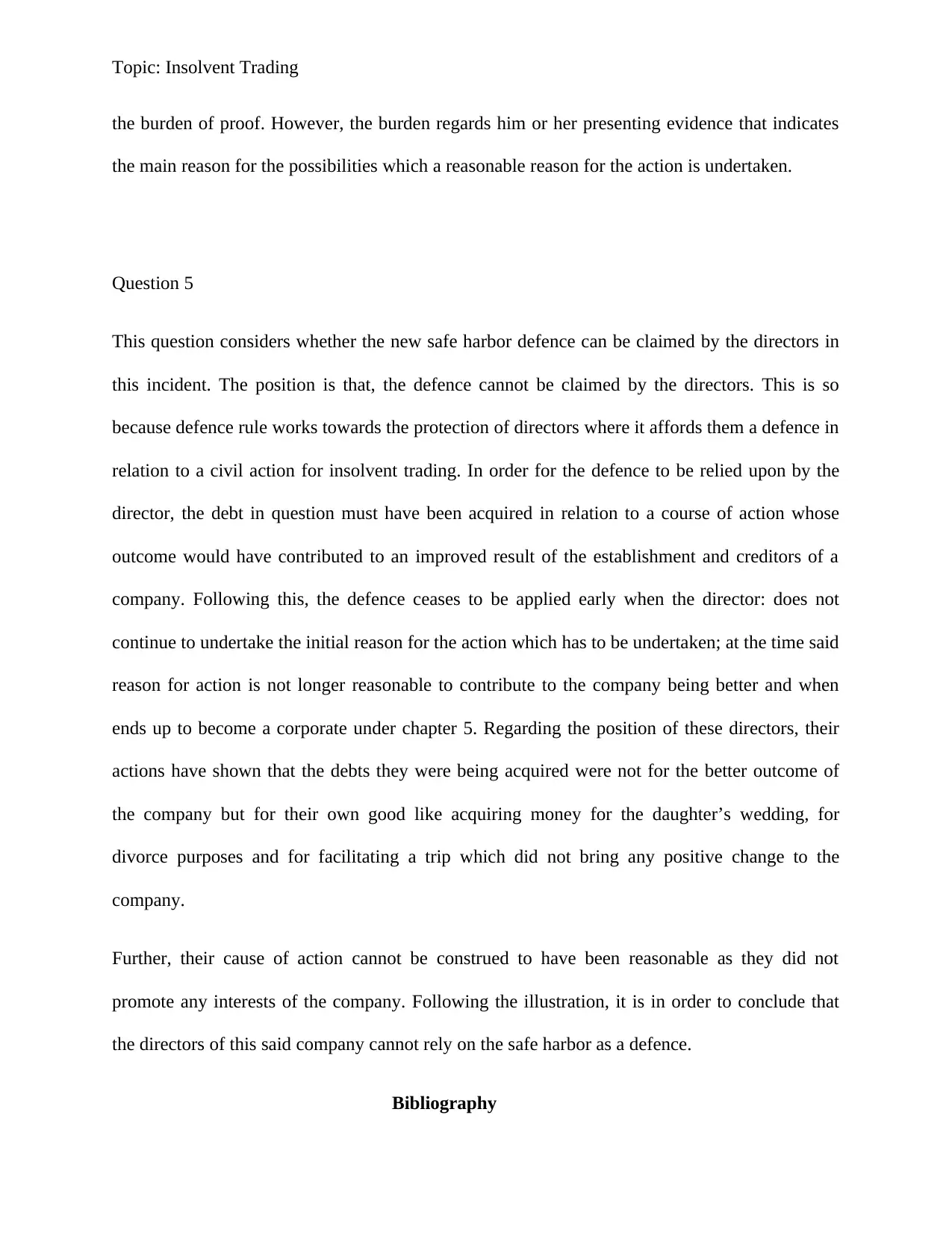
Topic: Insolvent Trading
the burden of proof. However, the burden regards him or her presenting evidence that indicates
the main reason for the possibilities which a reasonable reason for the action is undertaken.
Question 5
This question considers whether the new safe harbor defence can be claimed by the directors in
this incident. The position is that, the defence cannot be claimed by the directors. This is so
because defence rule works towards the protection of directors where it affords them a defence in
relation to a civil action for insolvent trading. In order for the defence to be relied upon by the
director, the debt in question must have been acquired in relation to a course of action whose
outcome would have contributed to an improved result of the establishment and creditors of a
company. Following this, the defence ceases to be applied early when the director: does not
continue to undertake the initial reason for the action which has to be undertaken; at the time said
reason for action is not longer reasonable to contribute to the company being better and when
ends up to become a corporate under chapter 5. Regarding the position of these directors, their
actions have shown that the debts they were being acquired were not for the better outcome of
the company but for their own good like acquiring money for the daughter’s wedding, for
divorce purposes and for facilitating a trip which did not bring any positive change to the
company.
Further, their cause of action cannot be construed to have been reasonable as they did not
promote any interests of the company. Following the illustration, it is in order to conclude that
the directors of this said company cannot rely on the safe harbor as a defence.
Bibliography
the burden of proof. However, the burden regards him or her presenting evidence that indicates
the main reason for the possibilities which a reasonable reason for the action is undertaken.
Question 5
This question considers whether the new safe harbor defence can be claimed by the directors in
this incident. The position is that, the defence cannot be claimed by the directors. This is so
because defence rule works towards the protection of directors where it affords them a defence in
relation to a civil action for insolvent trading. In order for the defence to be relied upon by the
director, the debt in question must have been acquired in relation to a course of action whose
outcome would have contributed to an improved result of the establishment and creditors of a
company. Following this, the defence ceases to be applied early when the director: does not
continue to undertake the initial reason for the action which has to be undertaken; at the time said
reason for action is not longer reasonable to contribute to the company being better and when
ends up to become a corporate under chapter 5. Regarding the position of these directors, their
actions have shown that the debts they were being acquired were not for the better outcome of
the company but for their own good like acquiring money for the daughter’s wedding, for
divorce purposes and for facilitating a trip which did not bring any positive change to the
company.
Further, their cause of action cannot be construed to have been reasonable as they did not
promote any interests of the company. Following the illustration, it is in order to conclude that
the directors of this said company cannot rely on the safe harbor as a defence.
Bibliography
Paraphrase This Document
Need a fresh take? Get an instant paraphrase of this document with our AI Paraphraser
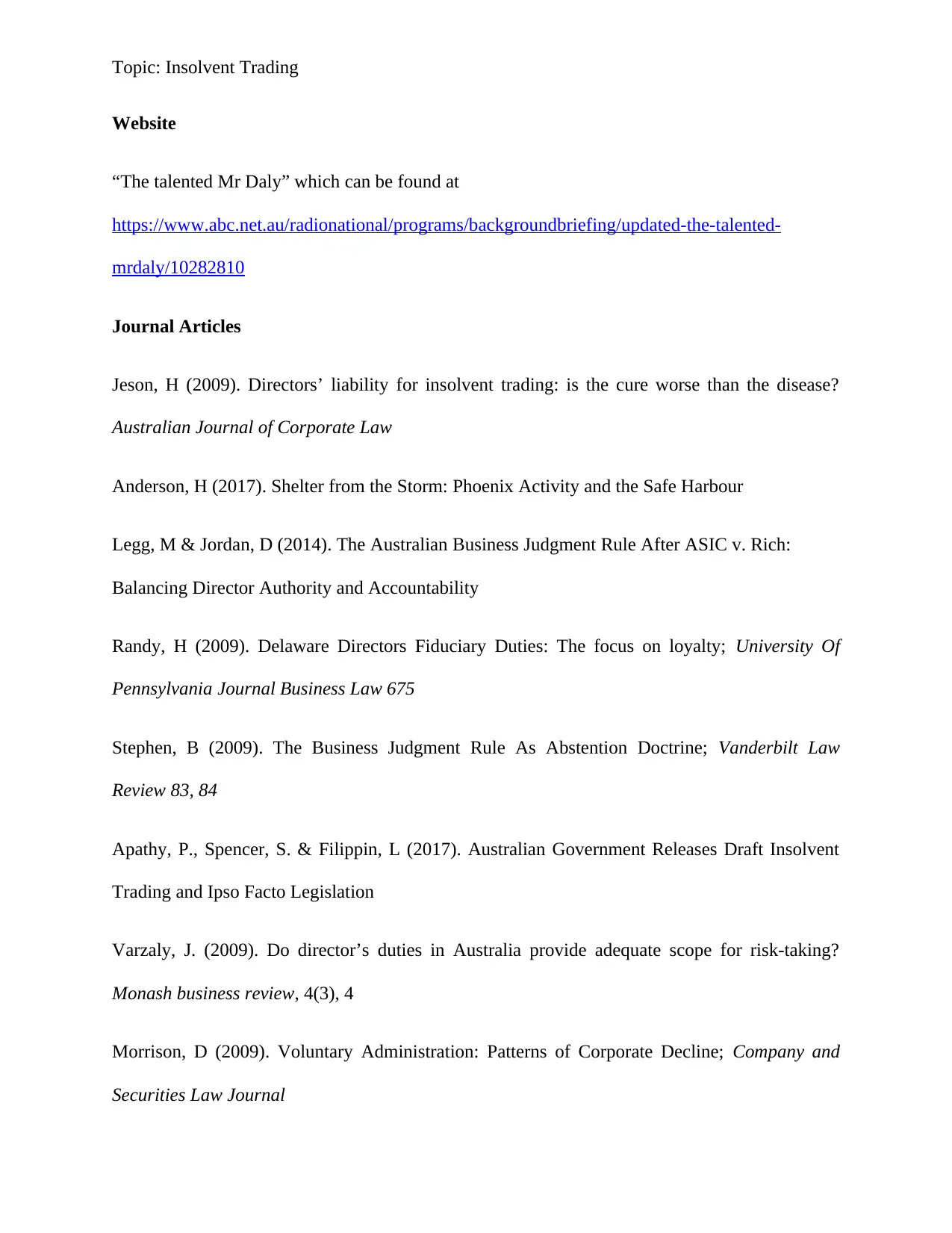
Topic: Insolvent Trading
Website
“The talented Mr Daly” which can be found at
https://www.abc.net.au/radionational/programs/backgroundbriefing/updated-the-talented-
mrdaly/10282810
Journal Articles
Jeson, H (2009). Directors’ liability for insolvent trading: is the cure worse than the disease?
Australian Journal of Corporate Law
Anderson, H (2017). Shelter from the Storm: Phoenix Activity and the Safe Harbour
Legg, M & Jordan, D (2014). The Australian Business Judgment Rule After ASIC v. Rich:
Balancing Director Authority and Accountability
Randy, H (2009). Delaware Directors Fiduciary Duties: The focus on loyalty; University Of
Pennsylvania Journal Business Law 675
Stephen, B (2009). The Business Judgment Rule As Abstention Doctrine; Vanderbilt Law
Review 83, 84
Apathy, P., Spencer, S. & Filippin, L (2017). Australian Government Releases Draft Insolvent
Trading and Ipso Facto Legislation
Varzaly, J. (2009). Do director’s duties in Australia provide adequate scope for risk-taking?
Monash business review, 4(3), 4
Morrison, D (2009). Voluntary Administration: Patterns of Corporate Decline; Company and
Securities Law Journal
Website
“The talented Mr Daly” which can be found at
https://www.abc.net.au/radionational/programs/backgroundbriefing/updated-the-talented-
mrdaly/10282810
Journal Articles
Jeson, H (2009). Directors’ liability for insolvent trading: is the cure worse than the disease?
Australian Journal of Corporate Law
Anderson, H (2017). Shelter from the Storm: Phoenix Activity and the Safe Harbour
Legg, M & Jordan, D (2014). The Australian Business Judgment Rule After ASIC v. Rich:
Balancing Director Authority and Accountability
Randy, H (2009). Delaware Directors Fiduciary Duties: The focus on loyalty; University Of
Pennsylvania Journal Business Law 675
Stephen, B (2009). The Business Judgment Rule As Abstention Doctrine; Vanderbilt Law
Review 83, 84
Apathy, P., Spencer, S. & Filippin, L (2017). Australian Government Releases Draft Insolvent
Trading and Ipso Facto Legislation
Varzaly, J. (2009). Do director’s duties in Australia provide adequate scope for risk-taking?
Monash business review, 4(3), 4
Morrison, D (2009). Voluntary Administration: Patterns of Corporate Decline; Company and
Securities Law Journal
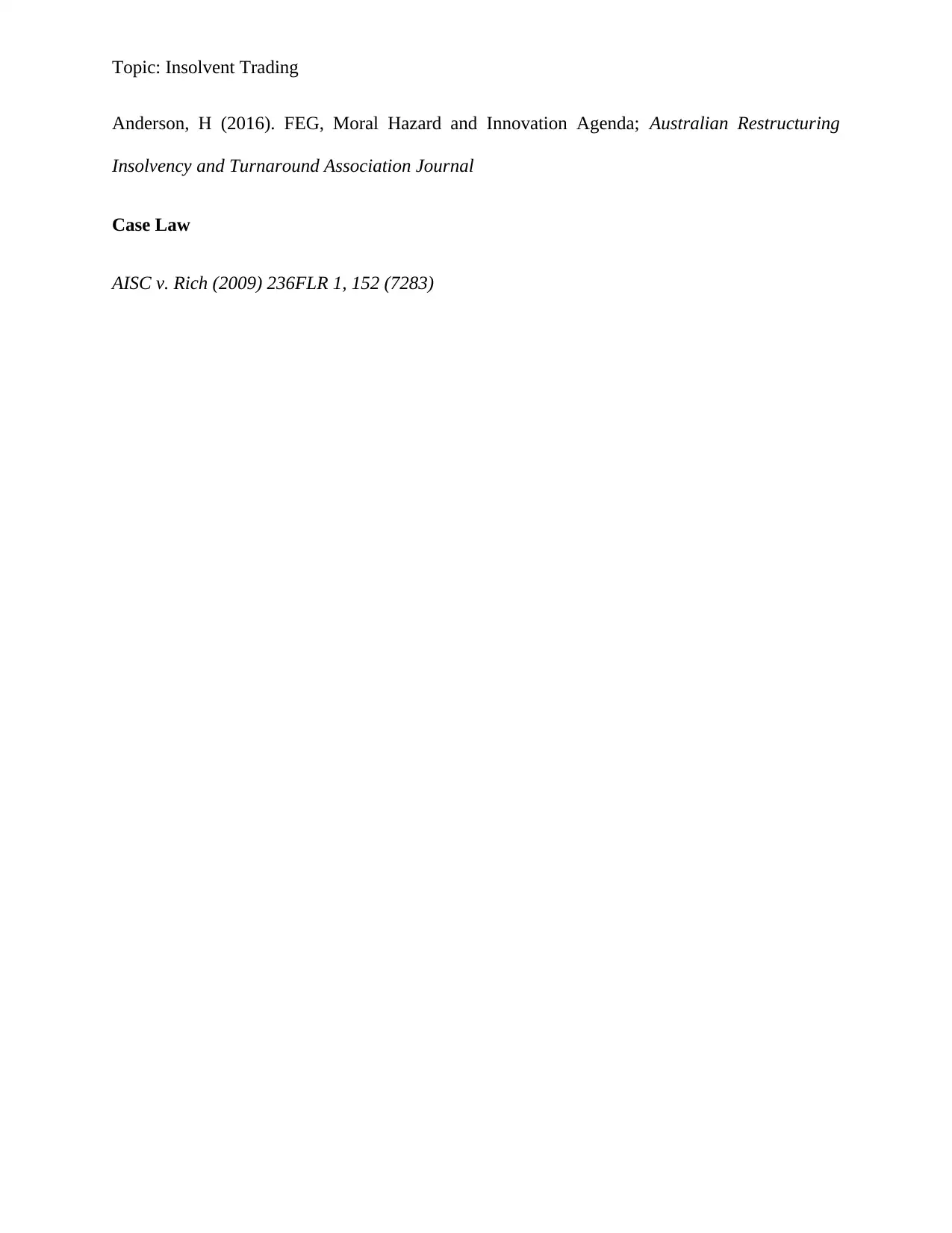
Topic: Insolvent Trading
Anderson, H (2016). FEG, Moral Hazard and Innovation Agenda; Australian Restructuring
Insolvency and Turnaround Association Journal
Case Law
AISC v. Rich (2009) 236FLR 1, 152 (7283)
Anderson, H (2016). FEG, Moral Hazard and Innovation Agenda; Australian Restructuring
Insolvency and Turnaround Association Journal
Case Law
AISC v. Rich (2009) 236FLR 1, 152 (7283)
⊘ This is a preview!⊘
Do you want full access?
Subscribe today to unlock all pages.

Trusted by 1+ million students worldwide
1 out of 12
Related Documents
Your All-in-One AI-Powered Toolkit for Academic Success.
+13062052269
info@desklib.com
Available 24*7 on WhatsApp / Email
![[object Object]](/_next/static/media/star-bottom.7253800d.svg)
Unlock your academic potential
Copyright © 2020–2025 A2Z Services. All Rights Reserved. Developed and managed by ZUCOL.





